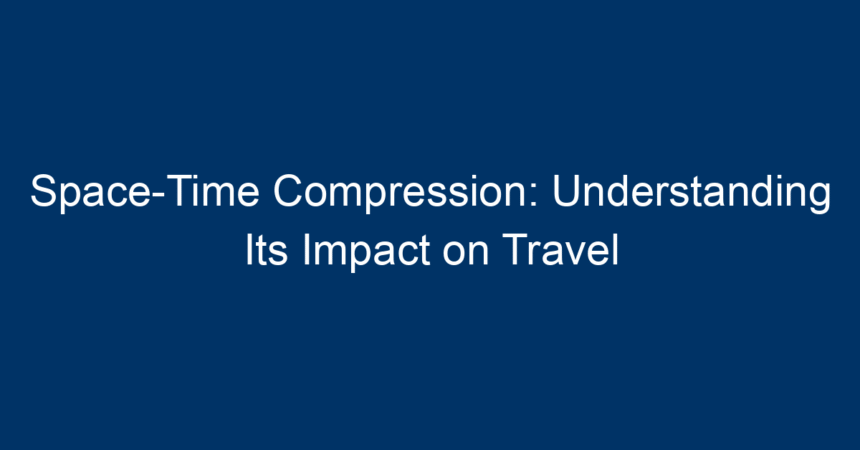In an era defined by rapid technological advancements and a globalized economy, the concept of space-time compression has taken center stage. This theory posits that advancements in transportation and communication technologies effectively shrink the world, making distances feel shorter and interactions quicker. As we delve deeper into this fascinating phenomenon, we’ll explore its impact on travel, geography, and even our everyday lives.
What is Space-Time Compression?
At its core, space-time compression refers to the ways in which time and space become more interconnected due to technological progress. The term was popularized by geographer David Harvey in the context of postmodern geography, emphasizing how advancements in transportation and communication technologies alter the spatial and temporal relationships between people.
Historical Context
To truly grasp space-time compression, it’s essential to take a brief look at its historical context. From the invention of the wheel to the steam engine, every major innovation in transportation has progressively shortened travel time. The introduction of commercial air travel in the 20th century marked a pivotal moment—what once took weeks or months now took mere hours. This shift has not only redefined our understanding of distance but has also revolutionized the concept of travel itself.
The Role of Technology in Space-Time Compression
Transportation
Transportation technologies have been at the forefront of enabling space-time compression. The progression from horse-drawn carriages to high-speed trains and commercial airlines demonstrates this evolution clearly. High-speed trains in countries like Japan and France can traverse vast distances in a matter of hours, fundamentally changing travel dynamics.
The Impact of Air Travel
Air travel epitomizes the concept of space-time compression. With jets flying at speeds upwards of 500 miles per hour, the world suddenly feels much smaller. A trip that once took weeks can now be accomplished in a day, allowing for a more interconnected global society. This has profound implications for business, tourism, and cultural exchange.
Communication
In tandem with transportation advancements, communication technologies like the internet and mobile phones have drastically altered how we connect with one another. Instant messaging and video conferencing have transformed long-distance communication, making it possible to maintain relationships across continents. Together, these developments contribute to a greater sense of immediacy and proximity in our interactions.
The Effects of Space-Time Compression on Travel Habits
Increased Mobility
Space-time compression promotes greater mobility among individuals. With the ease of travel, people are more inclined to explore, work, or live in different parts of the world. This increase in mobility fosters cultural exchange and diversity, enriching local communities with different perspectives and experiences.
Changing Tourism Trends
The tourism industry has witnessed significant shifts due to space-time compression. Unprecedented access to remote destinations is now possible, with travelers venturing to places that were once considered off the beaten path. Moreover, last-minute travel deals are more common, allowing spontaneous trips to various global hotspots.
Economic Opportunities
Economic implications of space-time compression can’t be overlooked. Businesses now consider global markets a viable option due to reduced travel time and costs. Companies are more likely to establish offices in various countries, leading to job creation and enhanced economic activity.
The Geographical Implications of Space-Time Compression
Shifting Urban Landscapes
As travel becomes faster and more common, urban areas evolve. Cities are no longer just local hubs; they are becoming part of a larger network of interconnected global cities. This interconnectedness influences urban planning, as cities adapt to accommodate increased populations and transit infrastructures.
The Decline of Distance
In practical terms, distances that once represented significant barriers to travel have diminished. For example, a person can leave London in the morning and arrive in New York by the afternoon. This decline in distance influences how we conceive of geography, pushing us toward a more global outlook.
Challenges Associated with Space-Time Compression
Environmental Considerations
Despite its numerous benefits, space-time compression raises environmental concerns. Increased travel, particularly air travel, contributes to carbon emissions and climate change. As the world continues to ‘shrink,’ we must also consider sustainable practices in tourism and transportation options.
Cultural Homogenization
As the world becomes more interconnected, the risk of cultural homogenization increases. Local traditions and practices may be overshadowed by dominant global cultures. Travelers must navigate this delicate balance, appreciating local customs while fostering cross-cultural interactions.
Conclusion: Embracing Space-Time Compression in Travel
As we look to the future, the concept of space-time compression will continue to shape the way we travel and interact with the world around us. Embracing this phenomenon means acknowledging both its benefits and its challenges.
Actionable Insights
-
Sustainable Travel: Prioritize eco-friendly travel options—consider using trains over planes for shorter distances, and choose airlines that emphasize carbon offset programs.
-
Cultural Engagement: Seek out authentic local experiences instead of sticking to tourist traps. This fosters a deep appreciation for the locations you visit.
-
Stay Informed: With advancements in travel technologies emerging regularly, keeping abreast of new options can enhance your travel experiences and broaden your horizons.
- Flexibility is Key: Be open to spontaneous travel opportunities that may arise from the ease of booking and the accessibility of various destinations.
In summary, space-time compression is a powerful force shaping our travel experiences, lifestyle choices, and cultural interactions. As our world continues to evolve, understanding and embracing this concept will be key to navigating the complexities and opportunities of our interconnected lives.




